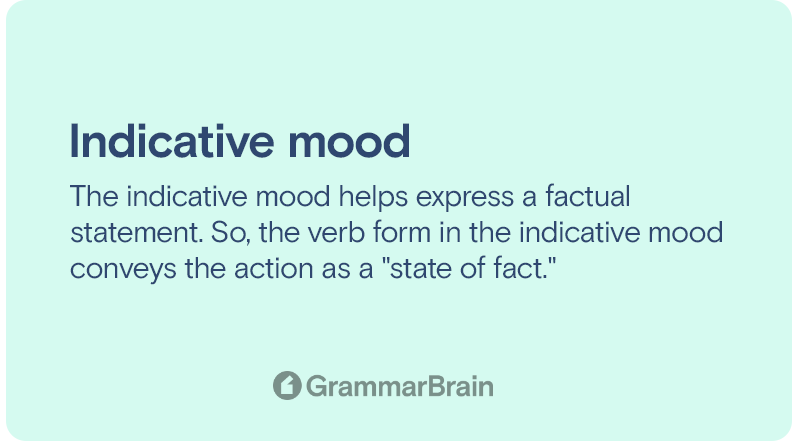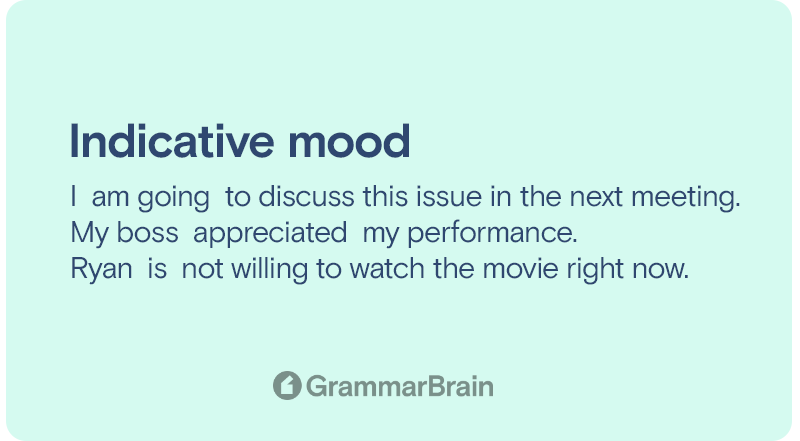What is the indicative mood? Even top grammar aficionados sometimes find it challenging to correctly use the five main moods. The indicative mood is the most common of the moods, and using it effectively can improve writing skills to a large extent.
In this article, we will discuss the indicative mood in detail, along with plenty of examples.

What is the indicative mood?
In grammar, a mood is a way to convey the attitude of the speaker or the writer. There are mainly five types of mood – indicative, imperative, interrogative, conditional, and subjunctive.
Out of these five moods, the indicative mood helps express a factual statement. So, the verb form in the indicative mood conveys the action as a “state of fact.”
It helps writers and speakers express information that sounds factual using declarative statements. It is also the only ‘realis’ mood among the five moods, conveying something real or factually accurate.

So, an indicative mood is a verb form that can either indicate a fact or deny it.
Let’s look at a few examples where the indicative verb form is bold:
- I am going to discuss this issue in the next meeting.
- My boss appreciated my performance.
- Ryan is not willing to watch the movie right now.
- Elizabeth will not be able to attend the seminar today.
- Eric will show you how to do the job.
Definition of an indicative mood
The indicative mood is defined as the verb form which indicates a fact, expresses an opinion, or asks a question through a statement. Most of the sentences in the English language exhibit an indicative mood.
Indicative moods can have different variations when using past, present, or future tenses. The key verb of a declarative sentence or an interrogative sentence (a question) will be contained in the indicative mood.

Examples of verbs in the indicative mood
Some examples of verbs in the indicative mood are as follows:
- The sun sets in the west.
- Is that bag blue or black?
- You have great taste in music.
- That was delicious. Did you enjoy it?
- I will be late reaching the office today.

What is a mood?
In English grammar, a mood is used to define how to regard a verb in a given sentence, whether it is a descriptive sentence or is conveying a wish or command. A verb mood is different from a verb tense, as the former emphasizes the quality of the verb rather than the time of action.
The grammatical mood is an effective tool for writers to create a strong impression. There are five types of mood in English grammar. They are discussed below:
- Indicative mood – Verbs in sentences that contain facts, statements, or questions.
- Example – He likes the reward.
- Imperative mood – Verbs in sentences that express a command or a request.
- Example – Clean your room right now!
- Interrogative mood – Verbs in sentences that convey a sense of uncertainty through a question.
- Example – Where have the kids gone?
- Conditional mood – This mood helps express a conditional statement, as the helping verb supports the main verb.
- Example – If you want to visit the club, you should finish work now.
- Subjunctive mood – This mood helps convey a wish, doubt, demand, or a hypothetical situation. The verb in this mood constantly changes.
- Example – I wish my wife were faster at making breakfast.
How to use the indicative mood
To use the indicative mood in a sentence, the speaker or the writer needs to believe he is stating a fact, denying a fact. He should think the spoken or written information is factually accurate.
For example:
- “Jacob is playing outside” (Speaker thinks it’s a fact.)
- “It will snow here in some time” (Speaker thinks it’s a fact.)
- “He is preparing for his chess match all day long” (Speaker thinks it’s a fact)
How to identify indicative mood
We use the indicative mood when talking about facts. If the verb form describes something that has happened, is happening, or will happen in the future – we know it’s an indicative mood.
FAQs
What are the 5 moods?
The five moods in English grammar are – indicative, imperative, interrogative, conditional, and subjunctive.
How do you know if it’s indicative or subjunctive mood?
We use the indicative of conveying information we consider to be factually accurate. On the other hand, we use the subjunctive to convey how we feel about those facts and to express uncertainty.
What is the difference between indicative and imperative mood?
The indicative mood creates a factually correct sentence. While the imperative mood helps convey commands or requests.
What is the difference between subjunctive and indicative mood?
The indicative mood is used to talk about facts, while the subjunctive mood talks about imaginary or hypothetical situations.
What are indicative rules?
The indicative verb form also follows the standard rules – singular noun with a singular verb (He was a gardener) and plural noun with a plural verb (She owns multiple cars).
Inside this article
Fact checked:
Content is rigorously reviewed by a team of qualified and experienced fact checkers. Fact checkers review articles for factual accuracy, relevance, and timeliness. Learn more.
Core lessons
Glossary
- Abstract Noun
- Accusative Case
- Anecdote
- Antonym
- Active Sentence
- Adverb
- Adjective
- Allegory
- Alliteration
- Adjective Clause
- Adjective Phrase
- Ampersand
- Anastrophe
- Adverbial Clause
- Appositive Phrase
- Clause
- Compound Adjective
- Complex Sentence
- Compound Words
- Compound Predicate
- Common Noun
- Comparative Adjective
- Comparative and Superlative
- Compound Noun
- Compound Subject
- Compound Sentence
- Copular Verb
- Collective Noun
- Colloquialism
- Conciseness
- Consonance
- Conditional
- Concrete Noun
- Conjunction
- Conjugation
- Conditional Sentence
- Comma Splice
- Correlative Conjunction
- Coordinating Conjunction
- Coordinate Adjective
- Cumulative Adjective
- Dative Case
- Determiner
- Declarative Sentence
- Declarative Statement
- Direct Object Pronoun
- Direct Object
- Diction
- Diphthong
- Dangling Modifier
- Demonstrative Pronoun
- Demonstrative Adjective
- Direct Characterization
- Definite Article
- Doublespeak
- False Dilemma Fallacy
- Future Perfect Progressive
- Future Simple
- Future Perfect Continuous
- Future Perfect
- First Conditional
- Irregular Adjective
- Irregular Verb
- Imperative Sentence
- Indefinite Article
- Intransitive Verb
- Introductory Phrase
- Indefinite Pronoun
- Indirect Characterization
- Interrogative Sentence
- Intensive Pronoun
- Inanimate Object
- Indefinite Tense
- Infinitive Phrase
- Interjection
- Intensifier
- Infinitive
- Indicative Mood
- Participle
- Parallelism
- Prepositional Phrase
- Past Simple Tense
- Past Continuous Tense
- Past Perfect Tense
- Past Progressive Tense
- Present Simple Tense
- Present Perfect Tense
- Personal Pronoun
- Personification
- Persuasive Writing
- Parallel Structure
- Phrasal Verb
- Predicate Adjective
- Predicate Nominative
- Phonetic Language
- Plural Noun
- Punctuation
- Punctuation Marks
- Preposition
- Preposition of Place
- Parts of Speech
- Possessive Adjective
- Possessive Determiner
- Possessive Case
- Possessive Noun
- Proper Adjective
- Proper Noun
- Present Participle
- Prefix
- Predicate



